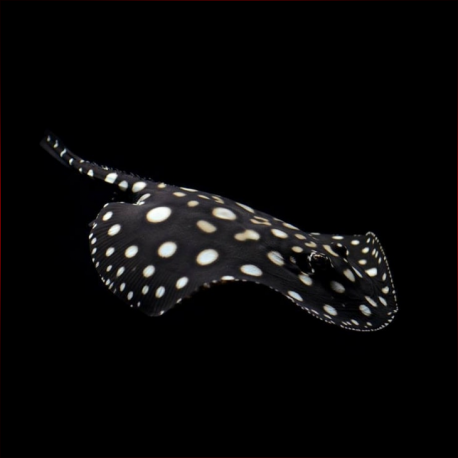More info
Datasheet
| Minimum Tank Size | 1700 litres / 449.09 US gallons |
| Maximum Size | 61.0cm / 24.02inches |
| Temperature | 20°C / 68.00°F - 29°C / 84.20°F |
| Hardness | 1-6ºdH |
| pH | 6.0-7.5 |
Behaviour
Rays are considered top predators in their natural ecosystems, caution is needed when selecting tankmates as they may prey on smaller or more aggressive species. They tend to thrive with larger, peaceful companions that occupy the upper tank levels, such as certain cichlids, characins, cyprinids, arowana, and some catfish species. Rays can be kept in groups, but hybridization should be avoided by mixing species. They are known for having a quiet demeanor but can become accustomed to their owners, even rising to the surface for food.
Feeding and Diet
In the wild, rays primarily feed on fish and aquatic invertebrates, needing a high protein diet. They are voracious eaters requiring feeding at least twice a day with a preference for meaty foods like mussels, prawns, squid, and earthworms. Live foods are initially crucial for conditioning newly imported rays. It is essential to avoid mammal meat like beef heart and feeder fish which can lead to health issues.
Reproduction & Dimorphism
Rays reproduce through matrotrophic viviparity, giving birth to fully-formed young after a gestation period of months. Successful breeding in captivity has been achieved, with litter size ranging from 1-8 pups. Sexual dimorphism is seen in males possessing claspers, visible extensions on the pelvic fins used for mating.
Habitat and Distribution
Potamotrygon leopoldi, also known as Polka Dot Stingray, is found in the Rio Xingu basin and Rio Fresco in central Brazil. Their natural habitats include sand banks, major river shallows, tributaries with mud/sand substrates, flooded forests, terrestrial lakes, and ponds. These freshwater rays exhibit diverse foraging behaviors and breeding adaptations to their specific ecosystems. Rays require warm water with stable parameters and ample swimming space in an aquarium setup.
Aquarium Setup
For a ray tank setup, warm, stable water conditions are crucial. Decor items like bogwood, smooth rocks, or branches can be added, but ensure they are secure as rays can shift them. Preferably, provide a sandy substrate mimicking their natural habitat. Strong biological filtration is necessary to manage waste, alongside regular water changes. Safety measures include a tight-fitting tank lid to prevent ray escapes during feeding and maintenance.

